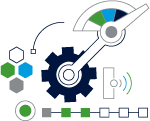AUTHOR
How it can make you a dollar or save you a dollar
Using Data Analytics in your Agribusiness aims to help you grow and improve efficiency. Many businesses have a large amount of data available to them. However, find it difficult to access all of the data in one place.
This makes it challenging for them to make important decisions for their company. With all this data, both internal and external, businesses can become overwhelmed and just not know where to start. With that context, here are a few areas that you need to consider when starting on a data analytics path for your business.
Data Capture
Most businesses capture data well. In Agribusiness, data can come from machinery, applications used in the field, sensors (Internet of Things), operations systems and from external sources, such as the weather, climate modelling and others in the supply chain. If there are areas where you are not accurately capturing the data, these need to be addressed before any other actions are taken.
Data Consolidation
A lot of businesses try to integrate all their systems together by sharing data between systems. This can be very difficult and very expensive. A better way to achieve the same goal is to extract all the data that you need from each of the systems and load it into a central data store, often called a Data Lake. There are several cloud-based technology platforms that do this very well.
Data Transformation
This is the most critical of all the stages in the process. This is where you can clean the data (data quality) and map the data to suit your specific needs. You model the data to help you answer the questions that you want to be able to ask from your data.
Business Intelligence (BI)
Now that you have your data in one central place, modelled to the way you want to be able to interact with it, use a leading data and analytics (BI) tool to visualize and interrogate your data. Be inquisitive and curious and ask lots of questions without fear of the answers.
This will enable you to do descriptive (what) analytics as well as diagnostic (why) analytics.
Use tools that utilise Artificial Intelligence (AI) and Machine Learning (ML) to move towards predictive (likely) analytics and prescriptive (action) analytics. These tools analyse past data to help predict what is likely to happen in the future and make decisions based on different scenarios.
Why would you want to embark on this? The simple answer is confidence to make better decisions based on data at the time you need to make them. You know your business better than anyone and ‘gut-feel’ has served you well. It can be difficult to rely on intuition and confidence alone when speaking to your financiers and suppliers. But when you have reliable data to support your decisions, everyone can feel more confident and move forward.
FOR MORE INFORMATION
If you would like to learn more about the topics discussed in this article, please contact your local RSM office.





